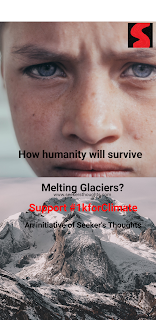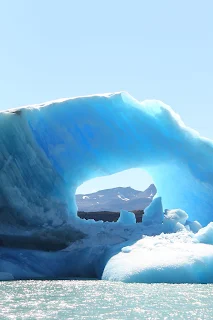The analysis shows that 8bn tonnes of ice are being lost every year and not replaced by snow, with the lower level glaciers shrinking in height by 5 meters annually.
Glaciers are not only contributors to the sea level rise but can also accumulate and release pollutants, as well as transform the chemical composition of water that originates or flows through them.
Most of the earth is covered with water in the form of oceans, and most of that contains salt. That means the freshwater content is lesser, as the earth has 97% of water is ocean water.
The remaining 3% is fresh water, and two-thirds of that is frozen in glaciers. Therefore, melting glaciers should be a priority.
What are Glaciers?
Glaciers are large masses of ice that can take many forms, from huge sheets to jagged blocks of slow-moving ice and rock. For billions of years, glaciers have carved the earth's surface and fed rivers and oceans with water.
Their presence is still felt even millions of years after melting away to create valleys, lakes and even mountains.
The rising population of humans... Read More
Rajasthan Becomes one of the hottest place to live...Read More
Rajasthan Becomes one of the hottest place to live...Read More
How do Glaciers Form?
A substantial amount of snow build up is needed for glacial ice to form. It's paramount that snow accumulating during winter surpasses that which melts away in the summer, by far. Snowflakes are the hexagonal water crystals. However, you need to know that layers of fluffy snowflakes are considered glacial ice yet.
As the accumulation of snow continues, the snowflakes buried underneath become a lot of more firmly packed together.
The tight packing triggers the snowflakes to assume round shapes while the hexagonal snowflake's shape gets disintegrated.
Over time, the well-rounded grains buried deep become heavily packed, driving out out a lot of the air that's imprisoned between the grains. The grainy shaped snow grains are referred to as firn and take about a year to form.
The dense, towering snowpark apply a huge amount of pressure on the layers of firns under.
The pressure causes the layers of firn to begin to melt slowly. The firn and meltwater gradually recrystallize to form glacial ice. This conversion process may well take years, decades or even centuries due to the fact the glacial ice formation is hugely pegged on the quantity of snowfall.
Melting is enabled because the temperature required for ice to melt is minimized as a result of the pressure applied by the weights of the top glacial ice. When the ice melts, the glacier may start to move. Although glaciers are known to move slowly, some move fast, 100 feet per day to be specific.
Glacier movement occurs in two ways; either retreating or advancing. However, these movements of glacier pretty much depend on where the cone-like nose is facing.
The downhill movement of the glacier causes chopping and remolding of the landscape, which explains the gorgeous landscaping scenarios on the mountain.
The Prominent Glaciers of the world.
There are few prominent glaciers in the world, and some of them are given below. The worry is that melting has impacted almost every glacier.
The Lambert glacier - Located in the Antarctica and measures about 515 kilometers long. It drains one-fifth of the Antarctica ice sheet every year. The Lambert Glacier feeds more than 35 km2 of ice to Prydz Bay every year.
The Novaya Zemlya Glacier: Located in the Arctic Ocean in northern Russia. It measures about 418 km in length.
The Arctic Institute Glacier: Located in the Antarctica and measures about 362 km in length.
The Nimros- Lennox- King glacier: Located in the Antartica. It measures about 290 km in length.
The Denman Glacier: Located in Antarctica. Measures about 241 km in length.
The Himalayan glacier is under threat
According to the Columbia University’s Lamont-Doherty Earth Observatory, who led the new research, said: “This is the clearest picture yet of how fast Himalayan glaciers are melting since 1975, and why.”
The research is published in the journal Science Advances. The scientists combined declassified US spy satellite images from the mid-1970s with modern satellite data to create the first detailed, four-decade record of ice along the 2,000km (1,200-mile) mountain chain.
The research is published in the journal Science Advances. The scientists combined declassified US spy satellite images from the mid-1970s with modern satellite data to create the first detailed, four-decade record of ice along the 2,000km (1,200-mile) mountain chain.
The analysis shows that 8bn tonnes of ice are being lost every year and not replaced by snow, with the lower level glaciers shrinking in height by 5 meters annually.
The study shows that only global heating caused by human activities can explain the heavy melting. In previous work, local weather and the impact of air pollution had complicated the picture.
It is really the doubling of the speed of glacier melt that is the most concerning. The new understanding of past melting means forecasts can now be made with far more confidence but the outlook is dire.
The previous report published in February found that at least a third of the ice in the Hindu Kush-Himalaya ranges was already doomed to melt by the end of the century, even if drastic action to cut emissions was taken immediately without action, two-thirds would go.
Either way serious consequences will be felt by those who rely on the great rivers that flow from the peaks into India, Pakistan, China, and other nations.
The evidence points to human-caused climate change being the dominant cause of the melting. The glaciers are shrinking at similar rates all along the mountain chain, indicating a common cause.
Weather changes and the settling of black air pollution, which absorbs heat from the sun and speeds up melting, have only local effects.
India is the most vulnerable country to climate - Why Himalayan glaciers are most important in the world?
More than 700 million people in India, Bangladesh, and Pakistan get their water from rivers that come from the Himalayan glaciers.
That’s more than twice the population of the US getting its water from, at root, a singular source.
These glaciers, like others in the world, are at risk of melting because of increasing temperatures and erratic weather patterns.
Glaciers depend on heavy precipitation to replenish ice on an annual basis. As monsoons in India are disrupted, ice vanishes.
As the glaciers melt, rivers flood. As rivers flood, people, crops, and livestock drown and hydroelectric plants are disrupted.
And the weaker monsoons mean less rainfall for the country as a whole, which means drought. Over time, of course, melting glaciers means less flowing water in general--so more drought.
There are 198,000 glaciers in the world. India contains about 9,000 of them, but these glaciers are mostly unexplored.
Other countries have invested far more in scientific expeditions than India. The lack of research prevents the country from fully understanding the state of its glaciers and the risk their loss poses.
There was an expectation that India’s glaciers would hold up better than others because they rely on monsoons as opposed to snowfall. But this hope appears to have been misguided--ice is receding at an alarming rate on some crucial glaciers.
This further compounds India’s already substantial exposure to climate change. In fact, India has been ranked the most vulnerable country to climate change by risk analysis company Verisk Maplecroft.
Dangerous level of flooding
113 million people in the country are vulnerable to dangerous levels of flooding. More than 300 million are vulnerable to drought and more than 700 million to extreme local storms.
Climate change will only accelerate in the years to come as global emissions continue to rise. There is some hope that economies are gradually transforming to reduce dependence on fossil fuels.
Recently, 193 countries signed the most ambitious climate agreement of all time. The plan isn’t perfect by any means. A lot more has to be sacrificed and committed by countries.
But the passage of COP21 marks the first time any actually binding agreement on climate has been globally ratified and it shows that world leaders are finally feeling the heat of environmental activists.


















No comments:
Post a Comment